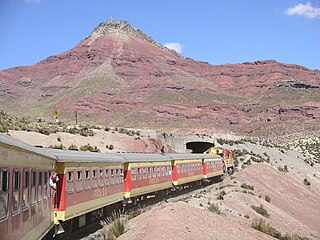
The Yauli Province is one of the nine provinces in Peru that form the Junín Region. It is bordered to the north by the Pasco Region and the Junín Province, to the east by the Tarma Province, to the south by the Jauja Province and to the west by the Lima Region. The population of the province was estimated at 66,093 inhabitants in 2002. The capital of the Yauli Province is La Oroya.
Huamboy is an archaeological site with cemeteries and a village on a hill of the same name in Peru. It is located in the Arequipa Region, Camaná Province, Nicolás de Piérola District. The complex was declared a National Cultural Heritage by Resolución Directoral Nacional No. 1106/INC on August 4, 2009.

Marayniyoq or Marayniyoc is an archaeological site in the region of Ayacucho in Peru. It lies southeast of the town of Huanta and southwest of Huamanguilla at the border of the Huanta Province, Huamanguilla District and the Huamanga Province, Pacaycasa District in a plain called Vega Pampa. It is considered a Wari site.
Quillcay Machay or Qillqay Mach'ay is an archaeological site in Peru. It is situated in the Huánuco Region, Huamalíes Province, Singa District. The site is known for its rock paintings. It was declared a National Cultural Heritage of Peru by Resolución Directoral No. 533/INC on June 18, 2002.

Inti Watana, Intiwatana or Pumaqucha is an archaeological site in Peru. It is located in the Ayacucho Region, Vilcas Huamán Province, Vischongo District, at the lake Pumaqucha.

Tinya palla or wiqru palla is a traditional dance of the Pomabamba Province in the Ancash Region in Peru. In 2009 the National Institute of Culture declared tinya palla a National Cultural Heritage of Peru by Resolución Directoral Nacional No. 491/INC-2009.
Quriwayrachina, Quri Wayrachina, Hatun Quriwayrachina or Hatun Quri Wayrachina is an archaeological site of the Inca period in Peru located in the Ayacucho Region, Lucanas Province, Carmen Salcedo District. It lies near the mountain Inka Pallanka which is venerated as an apu by the people of the area. There are two platforms which are known as Hatun Quri Wayrachina and Huch'uy Quri Wayrachina by the locals. On April 20, 2011, the site was declared a National Cultural Heritage by Resolución Viceministerial No. 459-2011-VMPCIC-MC.

Isog is an archaeological site in Peru. It is situated in the Huánuco Region, Huamalíes Province, Tantamayo District. The site was declared a National Cultural Heritage by Resolución Directoral No. 533/INC on June 18, 2002.
Huichún is an archaeological site in Peru. The National Institute of Culture declared it a National Cultural Heritage by Resolución Directoral No. 1572 on September 27, 2006. The site consists of houses, stone tombs (chullpa), deposits (qullqa) and enclosures.
Chichakuri is an archaeological site in Peru consisting of stone tombs (chullpa), walls, houses and squares. The place was declared a National Cultural Heritage by Resolución Directoral Nacional No. 296/INC-2003 by the National Institute of Culture on May 16, 2003. Chichakuri is situated in the Puno Region, Carabaya Province, Ollachea District, at a height of about 2,800 m (9,200 ft).
Hatunmarka is an archaeological site in Peru. It is located in the Junín Region, Jauja Province, Marco District. The site was declared a National Cultural Heritage by Resolución Directoral Nacional No. 1346 in November 2000.

Intikancha is a mountain with an archaeological site of the same name in the Andes of Peru, about 4,400 metres (14,436 ft) high. It is located in the Puno Region, Lampa Province, Nicasio District, and in the San Román Province, Juliaca District.
Cuchi Machay is an archaeological site with rock paintings in Peru. It is located in the Lima Region, Yauyos Province, Tanta District. Cuchi Machay was declared a National Cultural Heritage of Peru by Resolución Viceministerial No. 011-2013-VMPCIC-MC on February 7, 2013.

Pirca Pirca is an archaeological site in Peru. It is located in the Lima Region, Yauyos Province, Tanta District. Pirca Pirca was declared a National Cultural Heritage of Peru by Resolución Viceministerial No. 011-2013-VMPCIC-MC on February 7, 2013. It lies north of Lake Paucarcocha.

Qunchupata is an archaeological zone in Peru. It is located in the Ayacucho Region, Huamanga Province, Ayacucho District. The site was declared a National Cultural Heritage (Patrimonio Cultural) of Peru by Resolución Directional Nacional No. 458-98-INC on December 15, 1998.
Aya Muqu is an archaeological site in Peru. It was declared a National Cultural Heritage by Resolución Directoral in 2003. Aya Muqu is in the Ayacucho Region, Lucanas Province, Chipao District.
Usqunta is an archaeological site in the Ayacucho Region in Peru. It was declared a National Cultural Heritage by Resolución Directoral National No. 024/INC on January 12, 2009. Usqunta is located in the Lucanas Province, on the border of the districts of Aucara, Cabana and Lucanas. It is situated on a mountain of that name which reaches about 4,400 m (14,436 ft) above sea level.
Hatun Misapata or Misapata is an archaeological site in the Ayacucho Region in Peru. It was declared a National Cultural Heritage by Resolución Viceministerial Nº 459-2011-VMPCIC-MC of April 20, 2011. Hatun Misapata is situated in the Lucanas Province, Aucara District.
Wamanilla or Misayuq Pata is an archaeological site in the Ayacucho Region in Peru. It was declared a National Cultural Heritage by Resolución Viceministerial Nº 459-2011-VMPCIC-MC of April 20, 2011. It is situated in the Huanca Sancos Province, Sacsamarca District, and in the Víctor Fajardo Province, Huancaraylla District.
Cheqollo is an archaeological site in Peru. It is located in the Cusco Region, Cusco Province, San Jerónimo District, north of San Jerónimo. The site was declared a National Cultural Heritage (Patrimonio Cultural) by Resolucion Directorial Nacional No. 514/ 2003.






